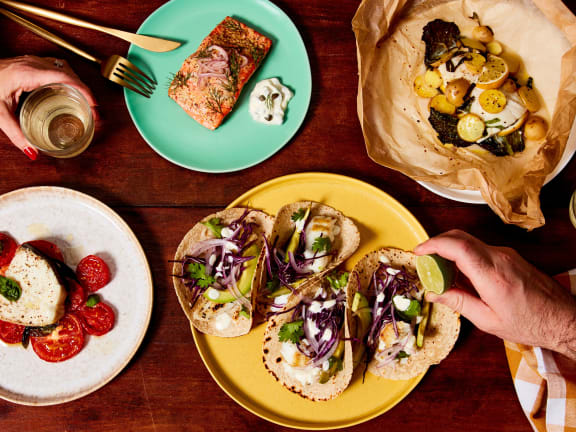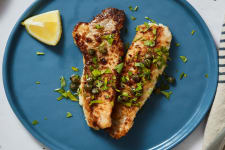Eating fish at least twice a week is one way to support your health. Easy weeknight recipes and interesting flavors can make it much easier for you to enjoy two servings of seafood per week, without getting bored.
Here are 5 dyanmic ways to ensure that you're eating enough seafood throughout the week:
Make a Stew/Soup/Chowder
Stews, soups, and chowders are no-fuss meals to make in big, easy batches. Make one on a Sunday, and it can last you and your family all week as a perfect back-up meal when you don’t have time to spend in the kitchen.
White fish like cod and halibut, cut into hearty chunks, are great additions to a pot full of Mediterranean flavors. Both fillets are substantial enough in texture to hold together in the stew — even if you’re reheating a bowl of leftovers — and their mildness meatiness will complement rather than compete with the flavors of the dish. Try this easy fish stew recipe from Martha Rose Shulman. It’s perfect for a rainy day when you don’t want to leave the house since it consists of basic pantry staples. Chances are you already have all of the ingredients you need. Salmon, with its richness, lends itself to stronger spices and flavors. This anti-inflammatory wild salmon curry soup from Dr. Andrew Weil is spicy and velvety with the addition of cashew milk, inspired by Thai cuisine.
Make Tacos
Even if you don’t enjoy cooking, there’s something undeniably fun about building your own meal on taco night, whether you’re with family or entertaining a group of friends. A sweet and smoky chipotle rub brings wild salmon to life after a quick five or six minutes on a hot grill pan and can be served warm or at room temperature with a bit of slaw and avocado.
Either cod or halibut can be used for a more conventional version of fish tacos, or undergo a gluten-free coconut-fried transformation. If your fillets are really thick like hefty fish steaks, just make sure to trim them down into thinner strips that will fry up more easily.
Make Gravlax
Homemade gravlax * is a must for breakfast lovers. Make a batch of gravlax on Sunday and you’ll have flavorful bits of protein to mix into your morning for the rest of the week. Use your gravlax in scrambles and frittatas; just remember to go easy on the salt when you’re seasoning the eggs, as the salmon will add plenty of that on its own.
**NOTE: Though the fish in gravlax is “cooked” by acid, it is still considered a raw form of seafood. Officially, we cannot recommend that you eat our salmon raw; and are required to inform you that consuming raw or undercooked seafood and shellfish may increase your risk of foodborne illness. There's a physiological change that wild salmon experience when they move from freshwater to saltwater (and back again), which makes them more susceptible to parasites found in freshwater. While we follow modern flash-freezing processes that help to kill off the parasites, we definitely recommend cooking our salmon before eating it.
If you’ve got a really sharp knife and some good knife skills, slice your cured salmon up nice and thin to serve with cream cheese and a bagel, garnished with salty capers and fresh onions. Note: If you’re slicing your gravlax ahead of time, be sure to store it in an air-tight, zip-top bag so that the pieces don’t dry out over the week.
Make Patties
Fish patties are the heroes of meal prep, perfectly freezable when made in big batches and easily packable for meals outside the home. A quick spin in the microwave or the toaster oven is all you need to make patties the perfect on-the-go snack or weekday lunch.
This recipe for potato and wild salmon cakes, easily made with last night’s leftovers, has an East Asian twist with the addition of ginger, sesame oil, and tamari — but feel free to play around with ingredient combos like dill and capers or jalapeno and cilantro. Or, try making this “no-recipe” cod cake from the New York Times. Either cod or halibut will do.
Make a Classic
Sometimes, less is more when it comes to your wild Alaskan catch. Whether you’re using wild cod, halibut, or salmon, the freshness and flavor of a high-quality fillet really shines through in a good old-fashioned pan-fry. Pan-frying your fillet is honestly easier than frying an egg and can require just salt and freshly-cracked pepper to enhance its out-of-this-world flavor. From there, you’re minutes away from pulling together a classic white wine caper-butter sauce.
Or, simply add some halved cherry tomatoes and shallots to your hot pan, adding in a bit of fresh olive oil and sautéing over medium heat until they begin to pick up some caramelized color. Spoon atop a white fillet of Pacific halibut or Pacific cod for a beautiful and tasty weeknight meal.






